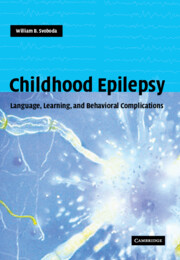Book contents
- Frontmatter
- Contents
- Preface
- Glossary
- 1 Looking ahead
- Part I Speech and language problems
- Part II Learning problems
- 12 Learning challenges
- 13 The development of learning
- 14 Learning difficulties
- 15 Learning problems with seizure types
- 16 Modifying factors
- 17 Transient cognitive impairments of epilepsy
- 18 Attention and alertness
- 19 Memory
- 20 Executive functioning
- 21 Academics
- 22 Antiepileptic medication effects
- 23 Effects of other therapies
- 24 Diagnosis
- 25 Gaining help
- 26 Frustrations of learning problems
- Part III Behavior problems
- Index
- References
17 - Transient cognitive impairments of epilepsy
from Part II - Learning problems
Published online by Cambridge University Press: 26 October 2009
- Frontmatter
- Contents
- Preface
- Glossary
- 1 Looking ahead
- Part I Speech and language problems
- Part II Learning problems
- 12 Learning challenges
- 13 The development of learning
- 14 Learning difficulties
- 15 Learning problems with seizure types
- 16 Modifying factors
- 17 Transient cognitive impairments of epilepsy
- 18 Attention and alertness
- 19 Memory
- 20 Executive functioning
- 21 Academics
- 22 Antiepileptic medication effects
- 23 Effects of other therapies
- 24 Diagnosis
- 25 Gaining help
- 26 Frustrations of learning problems
- Part III Behavior problems
- Index
- References
Summary
Epilepsy may interfere with learning in at least six ways. Direct disruption of ongoing processing by epileptiform activity may interfere with the attending to, processing of, storing of, and retrieving incoming information, which may be task-specific. Discharges temporally distant from the learning experience may disrupt consolidation processes by which information is encoded, stored, and retrieved. Permanent damage to neural tissue reduces its ability to react adaptively to new information. In the developing brain, this may be compensated for by a degree of plasticity. In the mature brain, damage may produce cognitive loss. Antiepileptic drugs may alter neural functioning related to learning processes. Frequent chronic discharges occurring during sleep may result in direct or indirect disruption of brain functions (Binnie et al., 1990). Subclinical epileptiform discharges in the EEG can adversely affect the child's performance (Henricksen, 1990). Subtle seizures are generally related to severe and global effects on cognitive functions, the most critical effects being on mentally demanding tasks (Aldenkamp et al., 1998).
In simultaneous EEG recording and intellectual testing, unilateral left-sided epileptic adults often show no responses when a discharge is occurred during testing (Kooi & Hovey, 1956). When a child has active seizures and related learning problems emerge, it is easy to envision the seizure discharges short-circuiting vital learning pathways. However, children have infrequent seizures or even have their seizures controlled but still have the learning disabilities and are found to continue to have frequent epileptiform discharges on the EEG. Is there a relationship?
- Type
- Chapter
- Information
- Childhood EpilepsyLanguage, Learning and Behavioural Complications, pp. 252 - 267Publisher: Cambridge University PressPrint publication year: 2004



